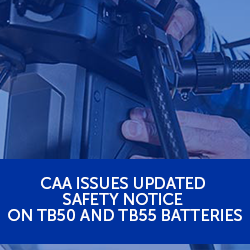
News
Published on 22 Nov 2018
James Willoughby
CAA issues updated safety notice on TB50 and TB55 batteries
An updated safety notice has been issued by the Civil Aviation Authority (CAA), lifting restrictions put in place following issues with some TB50 and TB55 batteries – as long as the drone operator can verify successful installation of DJI’s ... Read More
CAA-issues-updated-safety-notice-on-TB50-and-TB55-batteries-large.png An updated safety notice has been issued by the Civil Aviation Authority (CAA), lifting restrictions put in place following issues with some TB50 and TB55 batteries - as long as the drone operator can verify successful installation of DJI's firmware workaround. The safety notice (SN–2018/011) was issued yesterday afternoon and applies to operators of multi-rotor small unmanned aircraft utilising DJI battery model TB50 or TB55, including all DJI Matrice 200 series (which includes the 200, 210 and 210 RTK platforms) and the DJI Inspire 2 (the affected SUA). It comes after a number of incidents last month, with reports that a small amount of these batteries had shown incorrect power levels, leading to loss of power mid-flight. TB50.jpg A TB50 battery. At the time, the CAA released an initial safety notice, to highlight the requirement for the SUA operator and/or remote pilot to be reasonably satisfied that flights could be safely made, restrict overflight of people at any height, to temporarily limit the scope of certain operational authorisations issued to operators of the affected SUA, and to provide updated information regarding battery management requirements while the affected SUA were airborne. Last Friday, DJI released a firmware update to the battery management system and is working on a permanent fix to the issue. In the wake of this, the updated CAA safety notice lifts restrictions for operators and pilots of the affected drones who can confirm that the firmware updates have been successfully installed.
THE NEW SAFETY NOTICE
The new safety notice by the CAA states: 'SUA operators and remote pilots are reminded of their responsibility to be reasonably satisfied that the flight can be safely made (Air Navigation Order 2016 (ANO) article 94(2)) and of the requirements of ANO article 241 that a person must not recklessly or negligently cause or permit an aircraft (ie. the affected SUA) to endanger any person or property. 'SUA operators and remote pilots should follow the advice and guidance provided by the manufacturer to install the full suite of firmware updates provided for users of the TB50 and TB55 batteries.' This guidance is available here. The new safety notice continues: 'Depending on the status of the firmware update that has been installed, the following operating limits apply: a) If SUA operators and remote pilots of the affected SUA are able to confirm that the full suite of firmware updates that were released on or after 16 November 2018 have been successfully installed, the affected SUA may be operated in accordance with the requirements of the ANO 2016 and any permission or exemption that has been issued by the CAA. b) If SUA operators and remote pilots of the affected SUA cannot complete the firmware updates or cannot confirm that the battery firmware has been updated:
i) In accordance with ANO article 257 operators of affected SUA are hereby directed not to permit any flight that involves overflight of any persons, whether or not they are under the control of the operator or remote-pilot, at any height.
ii) In accordance with ANO article 253, any element of any permission or exemption based on an Operating Safety Case, issued by the CAA to an SUA operator which permits the operation of an affected SUA to be operated:
• within 50 metres of any person;
• within 50 metres of any, vessel, vehicle or structure which is not under the control of the SUA Operator or remote pilot of the SUA; or
• over or within 150 metres of an open-air assembly of more than 1,000 persons;
is suspended. This does not affect the ordinary operation of Article 95 of the ANO.
iii) If, at any time while the aircraft is in flight, the indicated voltage is displayed as 3.7V or lower, the aircraft must be landed immediately, as recommended by the manufacturer. Remote pilots should therefore plan their flights so that they can land with a minimum of 3.7V indicated (approximately 30% of full charge).
iv) Remote pilots must not rely on the state of charge only.'
ADVICE FOR THE EMERGENCY SERVICES
In relation to the emergency services, the CAA safety notice states: 'Due to the unique nature of emergency services operations, the privileges contained within General Exemption E 4506 (ORS4 No. 1233) may continue to be exercised while using the affected SUA, provided that the potential risks highlighted in this safety notice have been considered within the decision to proceed and the overflight of uninvolved persons is minimised.' TB55.jpg A TB55 battery. Operators or remote pilots experiencing further occurrences, or related issues, should report these directly to both the manufacturer and the CAA. Any queries about the updated safety notice should be emailed to UAVEnquiries@caa.co.uk with the subject line Safety Notice - DJI Battery TB50 and TB55 In-Flight Power Failures. Technical advice should be sought directly from the manufacturer. This safety notice will remain in force until further notice.
CAA STATEMENT
A CAA statement said: "After reviewing evidence from DJI, we are in a place to remove some of the current restrictions if an operator can successfully apply the DJI workaround (and verify this). We do ask that all operators still proceed with caution and immediately return to home or hover if the device doesn’t behave as expected. We continue to monitor this issue daily, working with DJI and reviewing operator feedback. We welcome anything further from operators on this matter."
